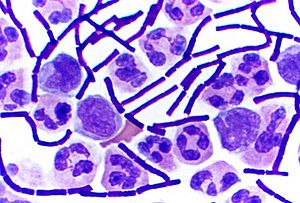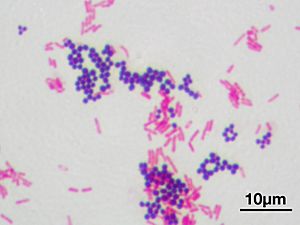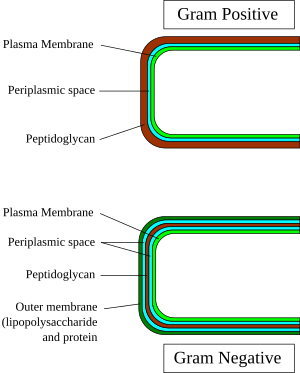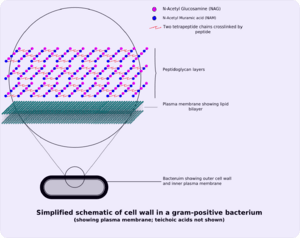Gram-positive bacteria facts for kids

Gram-positive bacteria are a special type of bacteria. Scientists use a test called the Gram stain to sort bacteria into two main groups. Gram-positive bacteria are one of these groups. They are named after Hans Christian Gram, who created the staining method.
When you do the Gram stain test, these bacteria turn purple. This happens because their cell wall has a thick layer of something called peptidoglycan. This thick layer holds onto the purple stain, even when the sample is washed.
The other group, Gram-negative bacteria, have a much thinner peptidoglycan layer. They also have an extra outer layer. This outer layer prevents them from holding the purple stain. Instead, they take on a pink or red color from a different stain used later in the test. Gram-positive bacteria are often easier to treat with certain antibiotics because they don't have this outer protective layer.
Contents
What Makes Gram-Positive Bacteria Special?
Gram-positive bacteria have some key features that make them unique. These features are mostly about their cell structure.
- They have a cytoplasmic membrane, which is like the skin of the cell.
- They have a very thick peptidoglycan layer. This layer is what makes them hold the purple stain.
- They also have special chemicals called teichoic acids. These acids help the bacteria stick to things.
- Their cell walls are made strong by a bacterial enzyme. This enzyme links the peptidoglycan chains together.
- They have a small space inside their cell wall called the periplasm.
Some gram-positive bacteria have a protective outer layer called a bacterial capsule. This capsule is usually made of sugars. Some can also move using tail-like structures called flagella. If they have flagella, they only have two rings to support them. Gram-negative bacteria have four rings. Both types of bacteria can have an S-layer on their surface. For gram-positive bacteria, this S-layer is attached to their thick peptidoglycan layer.
How Scientists Classify Bacteria
The Gram stain test is a quick way to tell different types of bacteria apart. It helps scientists classify them. This classification, along with other tests, helps us understand bacteria better. It also helps us know which antibiotics might work against them.
In the past, scientists used to divide all single-celled organisms into four main groups. Two of these groups were based on the Gram stain. However, modern studies using DNA have shown that the Gram stain doesn't always group bacteria together perfectly based on their family tree.
Today, scientists use DNA studies to classify bacteria. They look at specific parts of the bacteria's DNA. These studies show that gram-positive bacteria actually belong to two main groups. One group has a high amount of certain DNA building blocks (G+C content). This group includes bacteria like Corynebacterium and Mycobacterium. The other group has a lower amount of these building blocks. This group includes bacteria like Bacillus and Clostridium.
The Importance of the Outer Cell Membrane
Scientists usually divide bacteria into gram-positive and gram-negative groups. This is based on how they react to the Gram stain. But this system can sometimes be confusing. This is because the staining result, the cell's structure, and its family group don't always match up perfectly.
All gram-positive bacteria have just one main outer layer, called a lipid bilayer. They also have that thick peptidoglycan layer that holds the stain. Some other bacteria also have only one outer layer but don't stain gram-positive. This might be because they don't have a peptidoglycan layer at all, like Mycoplasma. Or their cell wall might not hold the stain well. Scientists have suggested calling bacteria with a single outer layer "monoderm bacteria."
In contrast, typical gram-negative bacteria have two outer layers. They have an inner cytoplasmic membrane and an outer bacterial outer membrane. Between these two layers, they have a very thin peptidoglycan layer. Bacteria with two outer layers are called "diderm bacteria."
Scientists believe that monoderm bacteria (gram-positive) are older, meaning they appeared earlier in history. The outer membrane in diderm bacteria (gram-negative) might have developed to protect them from antibiotics. This is because gram-positive bacteria are major producers of antibiotics, and gram-negative bacteria are often resistant to them. Some bacteria, like Deinococcus, are interesting. They stain gram-positive but also have an outer membrane. They might be a link between the single-layered and double-layered bacteria.
Exceptions to the Rule
While generally gram-positive bacteria have one layer and gram-negative have two, there are exceptions. Some bacteria don't have peptidoglycan at all, so they don't stain clearly. Others, like Deinococcus–Thermus, stain gram-positive but actually have two layers, like gram-negative bacteria. And some, like Chloroflexi, have one layer but stain gram-negative.
Some bacteria that are closely related to gram-positive bacteria also have two layers, even though they are expected to have one. These exceptions show that classifying bacteria is complex. Scientists use many different methods, including DNA analysis, to understand these tiny organisms.
Gram-Positive Bacteria and Health
Some gram-positive bacteria can cause diseases in humans. Here are a few important ones:
- Streptococcus and Staphylococcus: These are round-shaped bacteria. They can cause many common infections.
- Corynebacterium and Listeria: These are rod-shaped bacteria that do not form spores.
- Bacillus and Clostridium: These are rod-shaped bacteria that can form tough, protective spores. Bacillus can live with or without air, while Clostridium needs to live without air.
Gram-positive bacteria can cause serious infections in newborn babies. They can also cause diseases in plants.
Bacteria can share their genetic material in a few ways. One way is called transformation. In transformation, a bacterium takes in genetic material from its surroundings. This material comes from another bacterium that has died and released its DNA.
Scientists have found that about 80 different types of bacteria can do this. This includes many important gram-positive bacteria. For example, Streptococcus pneumoniae and Staphylococcus aureus can take up new genes this way. This process helps bacteria adapt and survive.
How to Write "Gram-Positive"
The words Gram-positive and Gram-negative come from the name of the scientist, Hans Christian Gram. Because they are named after a person, the first letter "G" can be either capital or lowercase. It depends on the specific writing rules you are following.
See also
 In Spanish: Bacteria grampositiva para niños
In Spanish: Bacteria grampositiva para niños







